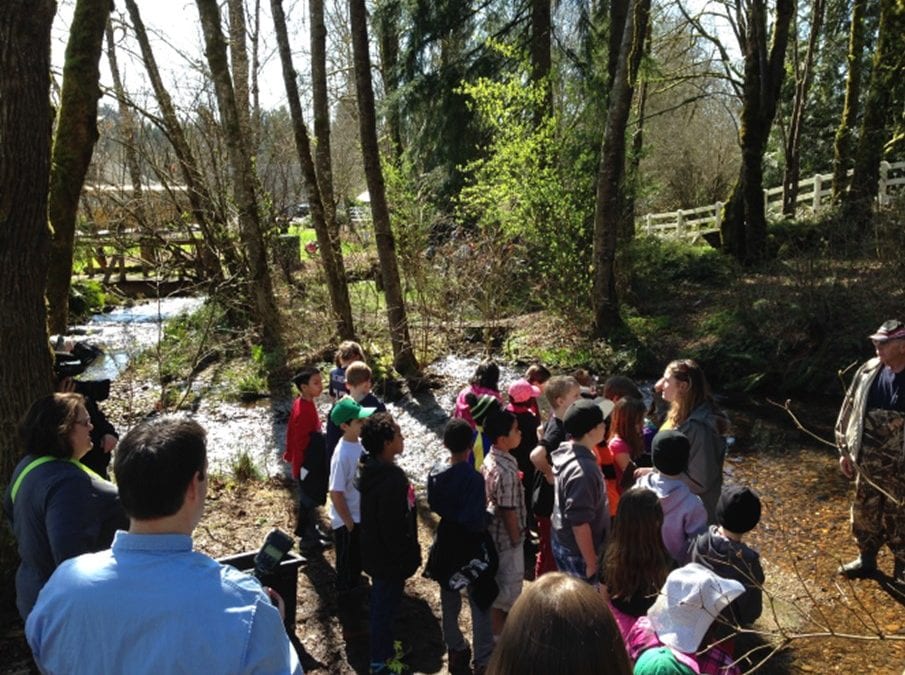The first fish release field trip I ever attended was at Jim and Barb Orander’s house, with 52 fourth graders from Hockinson Elementary. It was my first year as Salmon in the Classroom Coordinator. At that point we only hosted a handful of fish release field trips. Luckily for me as a rookie, I had two incredible teachers to fill me in on all the details: Carolyn Blain and Renee Fern from Hockinson Elementary. These are two amazing educators who foster a love of learning, stewardship and community among their students. They are the perfect teachers to bring to life a program that nurtures a personal connection with salmon and their habitat.

Above: Renee Fern (left) and Carolyn Blain (right) holding 250 eggs in a plastic cup at a January pickup. This “Dream Team” brought Salmon in the Classroom to life for countless 4th graders.
Hockinson is one of over 40 schools who participate in Salmon in the Classroom (SITC), raising 250 coho salmon eggs in an aquarium each January. After learning about salmon throughout the year, they release the fry into the Salmon Creek watershed. Fourth grade teacher Renee Fern started with SITC back when the program first began 20 years ago, with teaching partner Lisa Swindell. Lisa left the program about 10 years ago, and Carolyn Blain took over as Renee’s teaching partner. Now that Renee has recently retired, Carolyn has recruited a new teaching partner to help with the salmon project next year, once things settle down from COVID-19.

Jim (pictured left) participates with Salmon in the Classroom in a different way, through the Remote Site Incubator program. He also receives eggs each January, although instead of 250 eggs in a tank, he raises 10,000 in a streamside incubator (basically a wooden box that floats in the stream). A beautiful small stream flows along Jim’s property down into Salmon Creek, and it looks perfect for salmon! Jim says that before he started raising salmon in 2001, no one had seen a salmon in that creek since 1985. Three years after he joined the program (the time it takes a salmon to swim to the ocean and back to the place they were born), he saw 13 returns. “I’m proud of the fact that we got something started here. It was a lot of years without any salmon, and now we’re getting salmon back,” he told me.
From the time we get the eggs from the hatchery, it takes roughly 6 weeks for them to hatch and develop into fry. During that time, Jim visits the incubator daily to check the eggs, remove any mortalities, and clean the screens on the incubator trays. Sometime between late February and early March, the salmon absorb all their yolk and change from alevin stage to fry stage. It’s at this point they are ready to be released. On release day, Jim and his wife Barb invite the Hockinson fourth graders on a field trip to their Battle Ground home, to celebrate the reunion of the salmon and their stream.


Above: (Left) These incubator trays filled with eggs will be placed into the floating wooden boxes that you see in the top right corner of this photo; (Right) The hatchlings have absorbed their yolk and are now fry ready for life in the stream.
The field trip is a blast, and is a cherished tradition among these fourth graders. Students rotate through a series of learning activities. Jim answers questions about the salmon and helps students scoop out some wiggly fry and release them into the stream. Columbia Springs’ education volunteers guide students in a search for macroinvertebrates. Stream Team’s Americorps members lead the Salmon Life Cycle Obstacle Course, where students pretend to be a salmon swimming to the ocean and back, dodging predators and jumping up waterfalls. And each year the teachers request a model dissection to prepare for the real fish dissection later in the spring. The festivities always conclude with cookies and apple cider on the porch. After the event, students write thank you letters to Jim, and reflect on what they learned.



Left: Students scoop out wriggling fry and wish them good luck on their journey to the ocean.
Below: Stream Team Americorps members lead the Salmon Obstacle Course, where students pretend to be salmon swimming through a dam turbine, dodge predators and jump waterfalls.


Below: Columbia Springs education volunteers lead the macros station, where students identify waterbugs (salmon’s favorite food!)




Last week, Jim let me know that this will be his last year raising fish. It feels like the end of an era, with both Jim and Renee retiring from the program. I know we’ll find another opportunity for Hockinson 4th graders to begin a new tradition, but we’ll miss the annual Orander fish release. It was my first fish release field trip, and where I learned how to play the salmon game! More than that, it was a pioneering partnership created by teachers and a community member, and a precursor to SITC’s current “fish release field trip season” where we now host 50 classes on field trips to Salmon Creek Park. And I’m so grateful to have had the chance to be part of this very special partnership. Thank you Jim and Barb Orander, Renee Fern and Carolyn Blain, Stream Team, and all our CS volunteers who helped make this event happen for 20 years!
(click here for a 2016 video of Jim explaining his involvement)


Above: (Left) Fourth graders look forward to the field trip each year; (Right) Barb and Jim Orander with the “Coho Award” after their first 10 years raising salmon.

